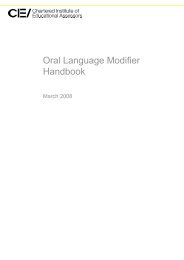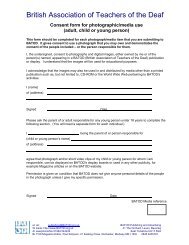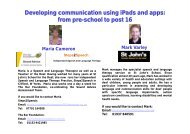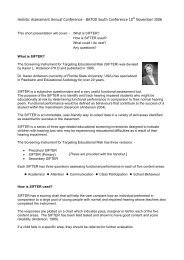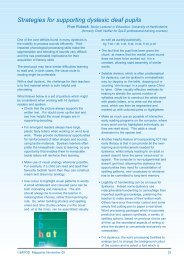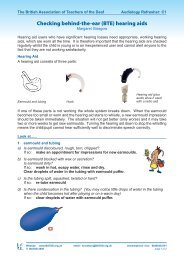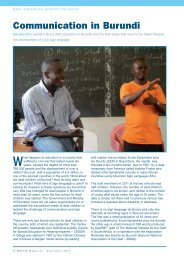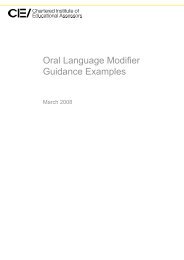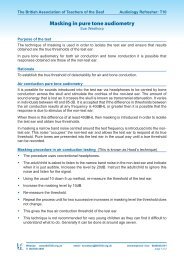In 2007, <strong>the</strong> SPM reported to <strong>the</strong> M<strong>in</strong>istryof Education <strong>and</strong> Research on an assignmentregard<strong>in</strong>g <strong>the</strong> harmonisation of <strong>the</strong> timetables of<strong>the</strong> different types of <strong>school</strong>s.Assessment <strong>and</strong> grad<strong>in</strong>gF<strong>in</strong>al assessment <strong>in</strong> <strong>school</strong> is carried out by <strong>the</strong>award<strong>in</strong>g of grades. To be awarded a Pass (G),<strong>the</strong> pupil must have at least have fulfilled <strong>the</strong>official ’goals to atta<strong>in</strong>’ – targets <strong>in</strong> syllabuses –that are specified <strong>in</strong> each type of <strong>school</strong> syllabus.With regard to <strong>the</strong> grades Pass with dist<strong>in</strong>ction(VG) <strong>and</strong> Pass with special dist<strong>in</strong>ction (MVG),<strong>the</strong>re are national criteria that <strong>the</strong> NationalAgency <strong>for</strong> Education, by order of <strong>the</strong>government, has adopted <strong>in</strong> special directivesthat are applicable to all types of <strong>school</strong>s.However, if <strong>the</strong>re are special reasons, <strong>the</strong> teachermay, when grad<strong>in</strong>g, disregard certa<strong>in</strong> goals that<strong>the</strong> pupil should have achieved or certa<strong>in</strong> criteriathat should have been fulfilled (SFS 1994:1194;SFS 1995:401). ’Special reasons’ refer to learn<strong>in</strong>gdisabilities or o<strong>the</strong>r personal conditions that arenot of a temporary nature <strong>and</strong> that constitute adirect obstacle to <strong>the</strong> pupil be<strong>in</strong>g able to achievea certa<strong>in</strong> goal or fulfil a certa<strong>in</strong> criterion.The fundamental pr<strong>in</strong>ciples of assessmentcarried out at <strong>the</strong> <strong>school</strong>s are relatively similar<strong>in</strong> <strong>the</strong> different types of <strong>school</strong>s. The special<strong>school</strong>s’ assessment is, however, made on <strong>the</strong>basis of criteria that <strong>in</strong> certa<strong>in</strong> respects are a littledifferent s<strong>in</strong>ce <strong>the</strong> teach<strong>in</strong>g is conducted from abil<strong>in</strong>gual perspective <strong>and</strong> <strong>in</strong>volves significantlymore visual elements than compulsory <strong>school</strong>.Sign language as a subject <strong>for</strong> pupils with normalhear<strong>in</strong>g <strong>in</strong> compulsory <strong>school</strong>s has <strong>the</strong> characterof a modern language (<strong>for</strong>eign language) ormo<strong>the</strong>r tongue (<strong>for</strong> pupils with <strong>deaf</strong>/hear<strong>in</strong>g<strong>impaired</strong> parents), while sign language <strong>in</strong> special<strong>school</strong>s has a key role as <strong>the</strong> first language.In special <strong>school</strong>s, sign language is also often<strong>the</strong> language of tuition <strong>for</strong> subjects, parallel towritten <strong>and</strong>/or spoken Swedish.So sign language has a different role <strong>in</strong> different<strong>in</strong>stitutions.Evaluation of educationThe goal of <strong>school</strong> is, through teach<strong>in</strong>g, whichimparts knowledge <strong>and</strong> necessary skills, toprepare <strong>the</strong> pupils both <strong>for</strong> work<strong>in</strong>g life <strong>and</strong> <strong>for</strong><strong>the</strong> cont<strong>in</strong>uation of lifelong learn<strong>in</strong>g (Rådet…2005). Broadly speak<strong>in</strong>g, <strong>the</strong>re are three waysof evaluat<strong>in</strong>g this goal: (1) by check<strong>in</strong>g that <strong>the</strong>pupil has learnt <strong>the</strong> skills that <strong>the</strong> <strong>school</strong> teaches,(2) by see<strong>in</strong>g whe<strong>the</strong>r <strong>the</strong> pupil, <strong>in</strong> adulthood,has succeeded <strong>in</strong> putt<strong>in</strong>g <strong>the</strong> skills <strong>in</strong>to practice,or (3) by evaluat<strong>in</strong>g whe<strong>the</strong>r <strong>the</strong> <strong>school</strong> reallydoes teach <strong>the</strong> <strong>in</strong>tended skills. These threemethods show different aspects of <strong>the</strong> quality of<strong>the</strong> <strong>school</strong>. In <strong>the</strong> follow<strong>in</strong>g assessment, <strong>in</strong> spiteof considerable differences between <strong>the</strong> types of<strong>school</strong>s, we have chosen to describe <strong>the</strong> results of<strong>the</strong> merit rat<strong>in</strong>gs, i.e. an evaluation of what <strong>the</strong>pupils have learned. We also attempt to describehow parents <strong>and</strong> teachers regard <strong>the</strong> <strong>school</strong>’spotential towards achiev<strong>in</strong>g <strong>the</strong> specified goals.This survey does thus not refer to how <strong>the</strong> pupilgroup, on <strong>the</strong> basis of what <strong>the</strong>y have learnedat special/compulsory <strong>school</strong>, manages at uppersecondary or to how <strong>the</strong>y apply <strong>the</strong>ir knowledge<strong>in</strong> adulthood <strong>and</strong> <strong>in</strong> <strong>the</strong> labour market.In recent years, Swedish <strong>school</strong>s have <strong>in</strong>creased<strong>the</strong>ir ef<strong>for</strong>ts to get as many pupils as possibleto achieve <strong>the</strong> knowledge goals. Not achiev<strong>in</strong>ga Pass <strong>in</strong> ma<strong>the</strong>matics, Swedish <strong>and</strong> Englishmeans that a pupil does not qualify to study onnational programmes at upper secondary <strong>school</strong>.This knowledge-oriented perspective of <strong>school</strong>22 <strong>Goal</strong> <strong>fulfilment</strong> <strong>in</strong> <strong>school</strong> <strong>for</strong> <strong>the</strong> <strong>deaf</strong> <strong>and</strong> hear<strong>in</strong>g <strong>impaired</strong>
also affects special <strong>school</strong>s, which only fiftyyears ago were significantly more practically <strong>and</strong>vocationally oriented.The goals <strong>in</strong> <strong>school</strong>, <strong>in</strong> addition to those that areknowledge-related, also <strong>in</strong>clude goals that arebased on society’s values. The goals cover ‘goalsto aim <strong>for</strong>’, which constitute <strong>the</strong> foundation of<strong>the</strong> system, <strong>and</strong> ‘goals to atta<strong>in</strong>´, which <strong>for</strong>m<strong>the</strong> basis <strong>for</strong> evaluation <strong>and</strong> assessment. Onemeans <strong>for</strong> achiev<strong>in</strong>g <strong>the</strong> goals is deemed to be<strong>the</strong> work<strong>in</strong>g environment. Special <strong>school</strong>s <strong>and</strong><strong>school</strong>s <strong>for</strong> <strong>the</strong> hear<strong>in</strong>g <strong>impaired</strong> have adapted<strong>the</strong>ir environment to a specific target group.By way of facilitation <strong>and</strong> compensation, <strong>the</strong>work<strong>in</strong>g environment enables <strong>the</strong> pupils tobenefit from <strong>the</strong> teach<strong>in</strong>g <strong>and</strong> to achieve <strong>the</strong>goals (Rådet… 2003). O<strong>the</strong>r hear<strong>in</strong>g <strong>impaired</strong>pupils should also have access, to vary<strong>in</strong>g degrees,to different types of adaptation <strong>for</strong> <strong>the</strong> purposeof mak<strong>in</strong>g <strong>the</strong> tuition accessible. Schools mustadapt <strong>the</strong>ir methods so that pupils requir<strong>in</strong>gsupport can, to as great an extent as possible,achieve <strong>the</strong> goals.Accord<strong>in</strong>g to <strong>the</strong> Education Act, <strong>school</strong> mustrest on a democratic foundation <strong>and</strong> everyonewho works <strong>in</strong> <strong>school</strong> must promote (<strong>the</strong> pupils’)respect <strong>for</strong> every <strong>in</strong>dividual’s <strong>in</strong>tr<strong>in</strong>sic value.Schools thus have a considerable responsibility,to ensure that <strong>the</strong> system lives up to <strong>the</strong>democratic goals of society.In this report, we present an evaluation of goal<strong>fulfilment</strong> <strong>in</strong> accordance with <strong>the</strong> syllabuses,through <strong>the</strong> collection of grades. We also assessparts of <strong>the</strong> curriculum’s general goals <strong>and</strong> valuesby way of questionnaires to parents <strong>and</strong> teachers.Who achieves <strong>the</strong> goals?The National Agency <strong>for</strong> Education reports that<strong>the</strong>re is a spread of merit rat<strong>in</strong>gs both between<strong>and</strong> with<strong>in</strong> <strong>school</strong>s (Skolverket 2005a; 2005dc).Differences between <strong>school</strong>s are normally lessthan differences with<strong>in</strong> <strong>school</strong>s. Accord<strong>in</strong>gto <strong>the</strong> National Agency <strong>for</strong> Education, gradedifferences between <strong>school</strong>s can be expla<strong>in</strong>edby factors o<strong>the</strong>r than <strong>the</strong> quality of teach<strong>in</strong>g. Itis well known that socioeconomic background,gender <strong>and</strong> ethnic background all affect pupils’merit rat<strong>in</strong>gs. Thus when one of <strong>the</strong>se categoriesbecomes too large at one <strong>school</strong>, <strong>the</strong> effecton that <strong>school</strong>’s total grade average <strong>in</strong>creases(Skolverket 2005c).There are, however, o<strong>the</strong>r factors than thosementioned above that affect a <strong>school</strong>’s, <strong>and</strong><strong>in</strong>dividual pupils’, grade averages. The NationalAudit reported that <strong>in</strong> 2006, only 57% of allpupils with disabilities achieved <strong>the</strong> goals <strong>in</strong>Swedish, English <strong>and</strong> ma<strong>the</strong>matics (Lar<strong>for</strong>s &Casson 2006). International studies <strong>and</strong> reportsare equally clear as regards <strong>the</strong> possibilities<strong>for</strong> pupils with learn<strong>in</strong>g disabilities to achieveknowledge goals <strong>in</strong> <strong>school</strong>. For <strong>in</strong>stance, studiesshow that children who have had men<strong>in</strong>gitis,one of several causes of severe hear<strong>in</strong>g loss<strong>and</strong> <strong>deaf</strong>ness, encounter an <strong>in</strong>creased risk ofdifficulties occurr<strong>in</strong>g at <strong>school</strong> (Grimwood et al.1995). A l<strong>in</strong>k is also reported between low birthweight <strong>and</strong> future <strong>school</strong>-related difficulties. Theread<strong>in</strong>g <strong>and</strong> numerical development of childrenwith hear<strong>in</strong>g impairment is also significantlyaffected if <strong>the</strong>y have additional disabilities(Resnick et al. 1999; Nafstad et al. 2002).It is thus also probable that <strong>school</strong>s with a largeproportion of pupils who have difficulties <strong>in</strong>addition to hear<strong>in</strong>g impairment <strong>and</strong> <strong>deaf</strong>nesshave a lower grade average.<strong>Goal</strong> <strong>fulfilment</strong> of hear<strong>in</strong>g <strong>impaired</strong> <strong>and</strong><strong>deaf</strong> pupils <strong>in</strong> <strong>school</strong>In <strong>the</strong> 1960s it was common <strong>for</strong> <strong>deaf</strong> childrennot to receive adequate language habilitationdur<strong>in</strong>g <strong>the</strong>ir pre-<strong>school</strong> years. In her 1993<strong>the</strong>sis, Heil<strong>in</strong>g <strong>in</strong>dicated that early habilitationef<strong>for</strong>ts <strong>in</strong>volv<strong>in</strong>g sign language <strong>and</strong> early read<strong>in</strong>gthrough spontaneous, play-related situations atpre-<strong>school</strong> <strong>in</strong> <strong>the</strong> company of adults <strong>in</strong>creased<strong>the</strong> possibility <strong>for</strong> <strong>deaf</strong> pupils to achieve moreknowledge goals. She has also subsequentlypo<strong>in</strong>ted out that <strong>the</strong> removal of <strong>the</strong> early learn<strong>in</strong>gof read<strong>in</strong>g with adult support could be onereason <strong>for</strong> <strong>the</strong> deterioration of <strong>deaf</strong> <strong>and</strong> hear<strong>in</strong>g<strong>Goal</strong> <strong>fulfilment</strong> <strong>in</strong> <strong>school</strong> <strong>for</strong> <strong>the</strong> <strong>deaf</strong> <strong>and</strong> hear<strong>in</strong>g <strong>impaired</strong>23
- Page 2 and 3: This is a translation of main parts
- Page 4 and 5: Goal fulfilment in school for the d
- Page 6 and 7: Table of Contents, contd.Concluding
- Page 8 and 9: Abbreviations and terms 1SPMSVSITTh
- Page 10 and 11: The Swedish Compulsory SchoolCompul
- Page 12 and 13: of teaching in different subjects,
- Page 14 and 15: The SPM has in the report “Pupils
- Page 16 and 17: In addition to the variation in typ
- Page 18 and 19: Attitudes to sign language, long re
- Page 20 and 21: Compulsory school for pupils withle
- Page 24 and 25: impaired pupils’ reading levels i
- Page 26 and 27: Method and implementationMethodPrev
- Page 28 and 29: Figure 1. Flow chart of the collect
- Page 30 and 31: 3,503,002,50Prevalence2,001,501,000
- Page 32 and 33: Table 7. Distribution of responses
- Page 34 and 35: ResultsTypes of schoolsSchools in S
- Page 36 and 37: 100908070Procent60504030Mild hearin
- Page 38 and 39: the 16 best grades in a pupil’s l
- Page 40 and 41: Table 10. The proportion (%) of pup
- Page 42 and 43: Table 14. Proportion (%) of boys aw
- Page 44 and 45: EnglishThe goals for the learning E
- Page 46 and 47: Table 22. Proportion (%) of pupils
- Page 48 and 49: It is also important to note that t
- Page 50 and 51: Table 26. Proportion (%) in respect
- Page 52 and 53: TeachersParents91878176 76726564Per
- Page 54 and 55: other types have used spoken langua
- Page 56 and 57: On the basis of the assessment resu
- Page 58 and 59: For instance, it can be mentioned t
- Page 60 and 61: Special Schools for the Deaf and Ha
- Page 62 and 63: LiteratureUnpublished sourcesConiav
- Page 64 and 65: Specialskolemyndigheten. . Hämtad
- Page 66 and 67: se>. Välj rubrik “Publikationer
- Page 68 and 69: Appendice I1II. Compulsory School (
- Page 70 and 71: Appendice IVIV. Special school for
- Page 72:
The National Agency for Special Nee



